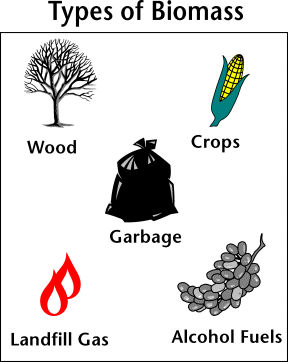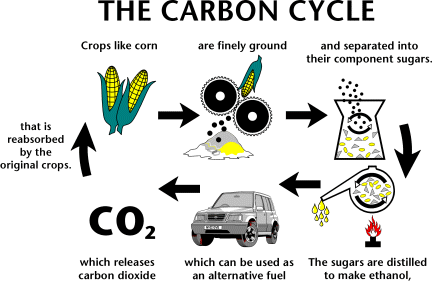
Wood was once our main fuel. We burned it to heat our homes and cook our food. Wood still provides a small percentage of the energy we use, but its importance as an energy source is growing less and less.
Biomass is organic material made from plants and animals. Biomass contains stored energy from the sun. Plants absorb the sun's energy in a process called photosynthesis. The chemical energy in plants gets passed on to animals and people that eat them. Biomass is a renewable energy source because we can always grow more trees and crops, and waste will always exist. Some examples of biomass fuels are wood, crops, manure, and some garbage.

When burned, the chemical energy in biomass is released as heat. If you have a fireplace, the wood you burn in it is a biomass fuel. Wood waste or garbage can be burned to produce steam for making electricity, or to provide heat to industries and homes.

Burning biomass is not the only way to release its energy. Biomass can be converted to other usable forms of energy like methane gas or transportation fuels like ethanol and biodiesel. Methane gas is the main ingredient of natural gas. Smelly stuff, like rotting garbage, and agricultural and human waste, release methane gas - also called "landfill gas" or "biogas." Crops like corn and sugar cane can be fermented to produce the transportation fuel, ethanol. Biodiesel, another transportation fuel, can be produced from left-over food products like vegetable oils and animal fats.
 .........
.......
.........
.......Sugar cane can also be used in the same way as coal. It is harvested and taken to a mill, where it is crushed to extract the juice. The juice is used to make sugar, whilst the left-over pulp, called "bagasse" can be burned in a power station.
The station usually provides power for the sugar mill, as well as selling electricity to the surrounding area.
ADVANTAGES
It is a very good idea to use up waste materials in a useful way. We are going to keep on making waste products, so biomass is renewable. We can always plant and grow more sugar cane and more trees, so those are renewable too. Biomass fuel tends to be cheap, and it makes less demand on the Earth's resources.
DISADVANTAGES
Collecting up biomass waste in sufficient quantities to use can be a difficult task. Also, when we burn the fuel, it makes greenhouse gases, in the same way that burning fossil fuels does. Also, some waste materials are not available all year round.